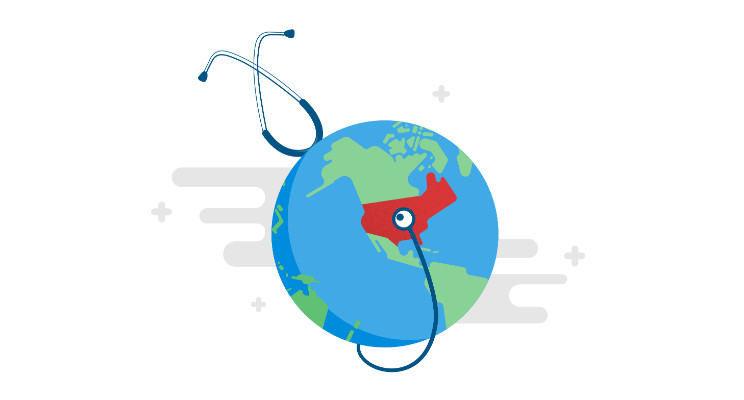The United States of America spends more money on healthcare per person than any other nation in the world but, unfortunately, that’s not enough. Despite spending about $10,586 on every citizen, millions of Americans are unable to afford and/or access medical assistance even in 2021. The main reason behind this anomaly is the ever-increasing cost of all things related to healthcare in the country.
Several suggestions have been made over the years to both identify and solve some of the core issues which are continuously elevating the cost of medical treatment in the US. Noting that this was the situation well before Covid-19 turned into a pandemic, the post-pandemic situation is even more dire than before. Looking ahead to 2022 and beyond, experts have suggested the following measures to address the problems that are actively and passively taking affordability out of healthcare in the States.
Creation of a Dynamic Consumer Healthcare Report System
It was suggested by Congressman Kevin Brady recently that all consumers should have access to an authentic, online resource that lists and updates the following in real-time:
- Location-centric prices of medicines, diagnostic tests, doctor’s fees, surgeon’s fees, hospital charges, cost of various treatments, medical equipment, etc.
- Data regarding success and failure rates for each treatment option available to the concerned patient.
- Updated data regarding the rate of HAIs at every registered hospital.
To make this happen, it must be made obligatory for all federally funded healthcare providers to participate and cooperate.
Additional Funding for Super-Expensive Meds
Blincyto is an immunotherapy drug by Amgen, which is delivered via IV infusions to treat acute lymphoid Leukemia (All), aka B-precursor acute lymphoblastic leukemia. In both adults and children with ALL, Blincyto has induced amazing remission rates (99.9%) at times, with a fraction of the side-effects expected from standard chemotherapy. Unfortunately, at $4,400 a vial and $712,000 per year, the drug is beyond the reach of most people who need it.
Y-mAbs Therapeutics’ Danyelza is another IV infusion drug that has proven itself to be highly successful in treating neuroblastoma, a rare form of cancer that almost exclusively affects infants and very young children. Patients need 48 vials of Danyelza in a year, which amounts to close to a million US dollars per year, at $20,000 per vial. Since the average medical insurance policy cannot cover such out-of-control prices, there must be additional funding from the government to bring it down.
To truly solve the issue of pricing lifesaving meds exorbitantly, the government needs to step in and legally prevent such pricing liberties. However, that is almost impossible at this point because it will require restructuring the entire US healthcare industry. Even if initiatives are taken on that front, it will be a gradual, long-term process. Until that time comes when the entire system has been reassessed and restructured, the government needs to focus on funding super-expensive meds that have the potential to save lives.
More States Must Grant Full Practice Authority to Nurse Practitioners
As of 2021, only 24 US States allow nurse practitioners to do what they are trained to do, which is diagnosing, treating, and prescribing medicine to patients at a comparatively affordable rate. Let’s take the pediatric nurse practitioner’s (PNP) role as an example since 1 million+ American children still don’t have access to or cannot afford pediatric care even in 2021. It is true that only 8% of pediatric NPs have the expertise and license to provide acute care to children, but that can change.
More PNPs can be trained with the help of accredited Acute Care Pediatric Nurse Practitioner DNP programs from schools like Baylor University. While this bodes well for children in the 24 states with an FPA allowance for NPs, plenty of sick children in the remaining 26 states will stay unattended and uncared for. State governments must accept the fact that they simply do not have enough pediatricians to cover all rural towns and villages. Also, no state government can provide affordable healthcare to every sick child living in low-income areas. If all 50 states decided to grant FPA to qualifying DNP-PNPs, pediatric healthcare could become a lot more accessible and affordable for poor families with sick children. This won’t solve the issue in its entirety, but it will definitely be a progressive step taken in the right direction.
Creating Awareness and Positive Reinforcement
If it was mandatory for healthcare insurers to offer higher coverage at a lower price to individuals who follow general health guidelines such as no-smoking, weight-control, low-alcohol consumption, active lifestyles, etc., it would incentivize people to be more wary of their poor lifestyle choices. It could have a drastic impact on national health. If the rate of preventable, lifestyle-related diseases were to come down, so would the tremendous financial pressure put on the ACA, Medicare, and Medicaid by such diseases.
For example, heart disease (675,068) and cancer (595,518) were still the two most deadly diseases in 2020, while Covid added an extra 327,847 deaths to the grim toll. Several studies conducted over multiple decades have confirmed the fact that there is a direct relationship between heart disease and being overweight/obese. Obesity also makes us more susceptible to various forms of cancer. Since people suffering from the two conditions may suffer for a long while before passing, it drains their own financials, as well as the federal/state medical aid resources. More people must be made aware that they do have a high chance of saving themselves from unnecessary pain and premature death by simply adopting a better lifestyle.
Finally, health insurance purchases and coverages and should not be limited to state borders. There should also be a robust verification system in place to prevent healthcare insurance fraud. Every time a fraudulent attempt by an individual or a corporate establishment succeeds, people who truly needed health insurance will suffer. Standardized, universal, and transparent insurance policies without unnecessary legal jargon and “fine prints” should be mandated by federal law.

